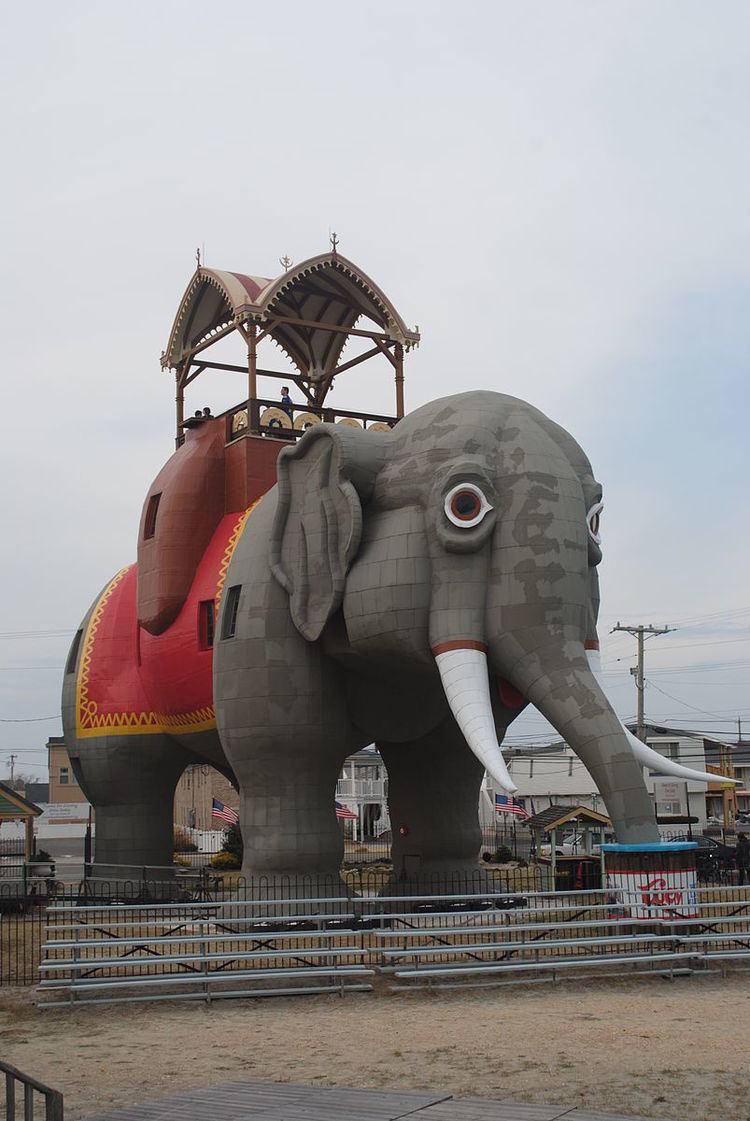Built 1881 NJRHP # 383 Designated NJRHP April 7, 1971 Opened 1882 Added to NRHP 12 August 1971 | NRHP Reference # 71000493 Designated NHL May 11, 1976 Height 20 m Phone +1 609-823-6473 | |
 | ||
Hours Closed today TuesdayClosedWednesdayClosedThursdayClosedFridayClosedSaturday11AM–4PMSunday11AM–4PMMondayClosed Similar Absecon Lighthouse, Steel Pier, Elephantine Colossus, Gillians Wonderland Pier, Playground Pier Profiles | ||
Lucy the elephant
Elephant hotel redirects here. For the National Historic Landmark located in Somers, New York, see Elephant Hotel.
Contents
- Lucy the elephant
- Weird nj visits lucy the elephant
- Patenting and Construction
- Early use and sale
- Other structures by Lafferty
- 1900s
- Save Lucy Committee and Restoration
- 2000s
- References
Lucy the Elephant is a six-story elephant-shaped example of novelty architecture, constructed of wood and tin sheeting in 1881 by James V. Lafferty in Margate City, New Jersey, two miles (3.2 km) south of Atlantic City. Originally named Elephant Bazaar, Lucy was built to promote real estate sales and attract tourists. Today, Lucy is the oldest surviving roadside tourist attraction in America.
Weird nj visits lucy the elephant
Patenting and Construction
In 1881, the U.S. Patent Office granted James V. Lafferty a patent giving him the exclusive right to make, use or sell animal-shaped buildings for a duration of seventeen years. Lafferty funded the design and construction of his first elephant-shaped building at South Atlantic City, now called Margate. He employed Philadelphia architect William Free for the design, and it was constructed at a cost of $25,000 - $38,000.
Initially named Elephant Bazaar, the structure stands at 65 feet (19.7 m) in height, 60 feet (18.3 m) in length, and 18 feet (5.5 m) in width and weighs about 90 tons. It is listed as the 11th tallest statue in the United States. Lucy was constructed with nearly one million pieces of wood, and required 200 kegs of nails, 4 tons of bolts and iron bars; 12,000 square feet of tin covers the exterior. There are 22 windows placed throughout the structure.
Early use and sale
Originally, Lafferty would bring potential real estate customers to the howdah (carriage) at the top, where he could point out parcels available for sale. Today,visitors to the roadside attraction may take guided tours through the building and access the howdah, which now serves as an observation deck, offering unique views of Margate, Atlantic City's skyline, the beach, and the Atlantic Ocean.
The structure was sold to Anton Gertzen of Philadelphia in 1887 and remained in the Gertzen family until 1970. Sophia Gertzen, Anton's daughter-in-law, reportedly dubbed the structure "Lucy the Elephant" in 1902. Lucy's head shape identifies the building as an Asian Elephant, and its tusks as a male. In its first few years, the elephant was referred to as a male, but today it is now generally considered to be female.
Other structures by Lafferty
Lafferty built two other elephant-shaped buildings, though neither survives. The Elephantine Colossus or Elephant Hotel, at Coney Island amusement park in Brooklyn, New York, stood 122 feet (37.2 m) tall, with seven floors of rooms, and legs 60 feet in circumference. It held a cigar store in one leg and a diorama in another, hotel rooms within the elephant proper, and an observation area at the top with panoramic sea views. It burned down in 1896. Another, officially named Light of Asia (dubbed Old Jumbo by locals), opened in Cape May in 1884, but was not successful and torn down within 15 years.
1900s
Through the first half of the 20th century, Lucy served as a restaurant, business office, cottage, and tavern (the last closed by Prohibition). The building was depicted on many souvenir postcards, often referred to as "The Elephant Hotel of Atlantic City." (The actual hotel was in a nearby building, not inside the elephant.)
